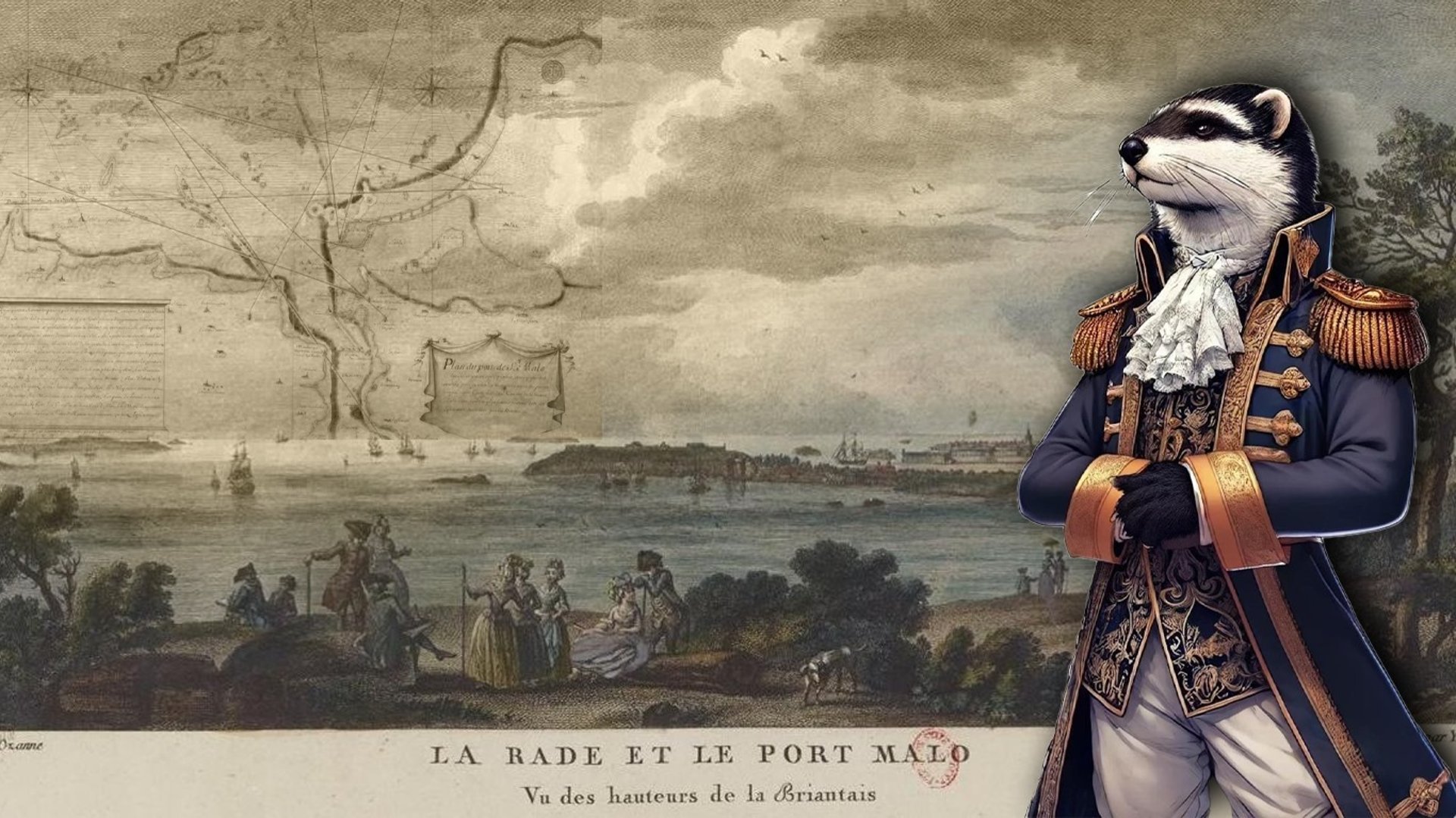The privateer-shipowners of Saint-Malo: a model of economic warriors (16th–18th century)
At the dawn of the 18th century, France expanded its power and influence across the seas through its shipowners. The port of Saint-Malo, a true "hornet’s nest," epitomized this model of economic and strategic power, blending global trade with privateering. By mastering a portion of maritime flows, the privateer-shipowners of Saint-Malo turned the oceans into a stage for their resilience and prosperity.
POWERSUPPLY CHAIN
Théophile Petit

At the turn of the 18th century, France stood as Europe’s dominant power, locked in economic competition with Great Britain and the Dutch Republic. Its global reach was anchored in an extensive network of colonial possessions and navigators who forged trade routes to the Americas, Africa, Asia, and the Caribbean. In this context, shipowners, who organized intercontinental maritime trade, acted as conduits for this influence. The port of Saint-Malo serves as a striking example of how France enhanced its power through the economy, both in times of peace and war.
Saint-Malo and trade with the New World
From the 16th century onwards, following the discovery of Canada by the Malouin navigator Jacques Cartier, Saint-Malo’s primary commercial activity was cod fishing off Newfoundland. The catch was sold across Europe and the Mediterranean, with Saint-Malo leveraging its strong ties to Marseille to extend trade into the Levant. Marseille-imported goods, such as soap, were redistributed by Saint-Malo to northern markets, along with goods from the West Indies and the Indies, positioning the city as a pivotal hub of European trade.
Seeking an edge over competitors, Malouin navigators explored distant markets. By gathering intelligence, they charted new trade routes and worked to monopolize them, often falsifying route declarations to protect their discoveries. This safeguarding of information, and sometimes deliberate disinformation, created an asymmetric advantage. In the 17th century, the abundance of precious metals in the Americas enriched the Spanish Empire, which prohibited their export. French merchants capitalized on the colonies’ vital needs, circumventing these restrictions and importing metals into France.
Risk and reward: inseparable partners
At the time, Brittany lacked the agricultural and industrial wealth of regions like the Seine, Garonne, Loire, or Rhine valleys. For Bretons, prosperity lay in fishing or long-distance trade. Financing maritime expeditions, however, was costly, ranging from 30,000 to 60,000 livres, covering the ship, manufactured goods, and provisions. Expeditions could last two to five years, often reaching as far as Latin America or the South China Sea. Roughly 9% of ships failed to return—a relatively low rate due to the quality of Malouin ships and crews. Despite the risks, the rewards were extraordinary: profits often reached 300% of the initial investment, a strategy of "all or nothing."
To sustain both intercontinental trade and European redistribution, the Malouin fleet included both large cargo ships and smaller coastal vessels for European commerce. This dual capability formed the two sails of Saint-Malo’s trade system. The wealth generated enriched around a hundred shipowning families, whose affluence is still visible today in the grand buildings of Saint-Malo and its surroundings. Another testament to this prosperity is the vast influx of silver, which made Rennes the leading monetary center in France for over a century between the 16th and 17th centuries.
Partnerships for growth
By the early 18th century, investors began pooling resources to minimize the risks of long voyages. Small traders, merchants, and landlords could buy shares in commercial shipping ventures. During wartime, when risks increased, the number of shareholders grew proportionally. This system, confined to Saint-Malo’s bourgeoisie, provided the sovereign funds needed to guarantee commercial expeditions and later to finance privateering during wars. Close ties among the city’s leading families facilitated this cooperative approach, driving the city’s development.
As early as 1601, Saint-Malo created the French East Seas Company to rival the Dutch East India Company in the spice trade. Though the venture failed, it paved the way for Colbert’s founding of the French East India Company in 1664. Struggling in the late 17th century, the company leased its privileges to Malouin shipowners, who held an 85% stake by 1714, securing a ten-year monopoly on Indian trade. In 1712, they established the Saint-Malo East India Company, making the Indian trade profitable for the first time in France, demonstrating the success of the private model over state-led initiatives. However, the company collapsed after being absorbed into John Law’s financial system in 1719. Meanwhile, a Malouin shipowner founded the Royal South Sea Company, opening a lucrative route to Chile’s coast and reclaiming privileges from a Parisian company.
Malouin privateers: naval warfare and economic warriors
The maritime model of Saint-Malo in the 16th and 17th centuries had two defining features: its ability to transition between commerce and warfare, and its nuanced independence from the French crown.
Saint-Malo adeptly adapted to the frequent wars waged by the French king, which disrupted commerce. Letters of marque, issued by the king, legally authorized shipowners to engage in privateering, allowing private ships to attack enemy commerce, often targeting British or Dutch vessels. Captured ships were returned to the crown, which received 25% of the spoils, with the remainder divided among the shipowner, captain, and crew after expenses.
Privateering ensured financial survival during wars but was not excessively profitable. The initial cost of arming privateer ships was steep—around one million livres, equivalent to a year’s expenditure on Saint-Malo’s cod fleet. This investment was often reinvested annually, with profits reintegrated into privateering efforts. The strategy was not solely financial; it was also tactical, aimed at weakening British and Dutch commercial fleets. Conversely, Anglo-Dutch forces sought to eliminate this "nest of wasps" harassing their trade. In 1693, they attempted a failed raid on Saint-Malo with an explosive-laden ship. Recognizing the city’s strategic importance, Vauban completed its defenses in 1689 with forts along the Rance estuary and the coast.
Financing war to prepare for peace
By supporting wartime efforts through privateering, shipowners contributed to peacemaking and secured royal favor. This favor often proved more profitable in the long run, granting shipowners leverage in shaping national regulations to their advantage.
Privateering was both a wartime adaptation and a long-term investment. Arming commercial ships ensured security during peacetime, creating a hybrid model of economic warfare. By the 18th century, many nations deployed privateers, while French coasts and ports were often blockaded. Additionally, Barbary corsairs, Caribbean pirates, and Malay raiders disrupted key trade routes. From the early 17th century, Malouin shipowners organized convoys and leased cannons to local lords, eventually industrializing production. By 1610, facing intensified hostility from Native Americans, the king authorized them to arm two ships at their own expense to protect fishing fleets. Over time, these convoys became routine, with other Breton ports contributing to costs under a 1643 legal decision by the Parliament of Brittany. This early model of armed commerce laid the foundation for 18th-century privateering and the city’s transition to intensive corsair activity.
A win-win relationship between city and state
Initially hindered by competition from royal squadrons monopolizing sailors, Saint-Malo emerged in the late 17th century as a key player in the crown’s privateering strategy. Malouin shipowners resisted Vauban’s plan to establish a royal squadron base in the city, preserving their autonomy. This resistance underscored the privatization of royal privateering efforts. The crown even loaned ships to private interests, combining royal vessels with Saint-Malo’s financial and human resources. During the War of the League of Augsburg and the War of Spanish Succession, Malouin merchants armed 14 and 60 ships, respectively, under this hybrid model.
In 1711, a fleet of 15 royal ships, financed by 700,000 livres from Malouin investors and manned by 5,600 sailors, launched a raid on Rio de Janeiro under Duguay-Trouin. The expedition, targeting Portugal as an ally of England, had significant economic objectives: seizing the annual shipment of gold. It returned with 1.3 tons of gold and 1.6 million livres worth of cargo, yielding a 92% profit for investors.
A culture of economic combat
Uniquely, Saint-Malo’s maritime model was almost sovereign. Its shipowners achieved financial and material independence. Decisions to engage in privateering rested solely with the shipowners, not the crown. This autonomous, cooperative culture stemmed from the city’s brief declaration of independence in 1590 to safeguard its commercial interests during France’s religious wars.
Bold in seizing economic opportunities and resilient in adapting to political fluctuations, the Malouins cultivated a culture of economic warfare. They developed a robust intercontinental trade system that seamlessly transitioned to privateering, establishing Saint-Malo as a commercial hub between overseas territories and Europe. Drawing lessons from economic cunning, public-private cooperation, and sovereignty-driven resilience, this history remains an inspiring model of economic intelligence today.
